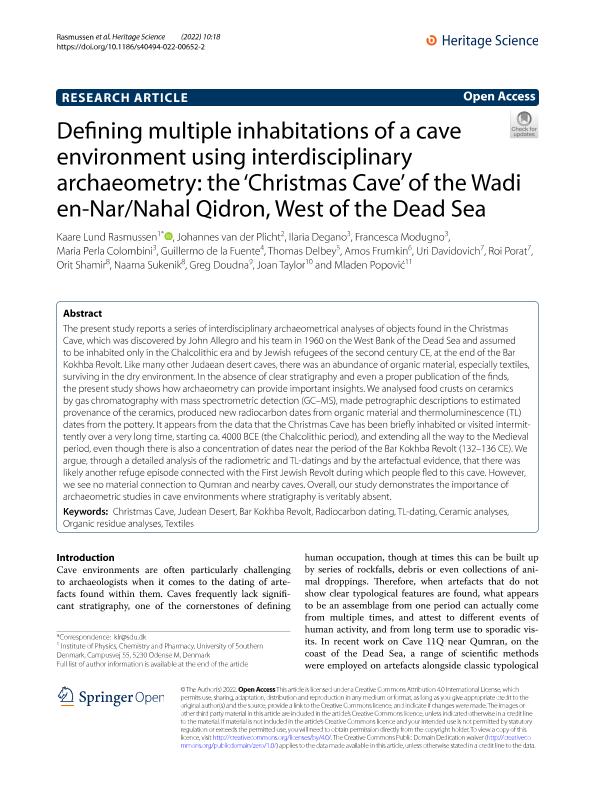Mostrar el registro sencillo del ítem
dc.contributor.author
Rasmussen, Kaare Lund
dc.contributor.author
van der Plicht, Johannes
dc.contributor.author
Degano, Ilaria
dc.contributor.author
Modugno, Francesca
dc.contributor.author
Colombini, Maria Perla
dc.contributor.author
de la Fuente, Guillermo Adrian

dc.contributor.author
Delbey, Thomas
dc.contributor.author
Frumkin, Amos
dc.contributor.author
Davidovich, Uri
dc.contributor.author
Porat, Roi
dc.contributor.author
Shamir, Orit
dc.contributor.author
Sukenik, Naama
dc.contributor.author
Doudna, Greg
dc.contributor.author
Taylor, Joan
dc.contributor.author
Popović, Mladen
dc.date.available
2023-10-11T20:28:48Z
dc.date.issued
2022-02
dc.identifier.citation
Rasmussen, Kaare Lund; van der Plicht, Johannes; Degano, Ilaria; Modugno, Francesca; Colombini, Maria Perla; et al.; Defining multiple inhabitations of a cave environment using interdisciplinary archaeometry: the ‘Christmas Cave’ of the Wadi en-Nar/Nahal Qidron, West of the Dead Sea; Springer; Heritage Science; 10; 1; 2-2022; 1-22
dc.identifier.uri
http://hdl.handle.net/11336/214941
dc.description.abstract
The present study reports a series of interdisciplinary archaeometrical analyses of objects found in the Christmas Cave, which was discovered by John Allegro and his team in 1960 on the West Bank of the Dead Sea and assumed to be inhabited only in the Chalcolithic era and by Jewish refugees of the second century CE, at the end of the Bar Kokhba Revolt. Like many other Judaean desert caves, there was an abundance of organic material, especially textiles, surviving in the dry environment. In the absence of clear stratigraphy and even a proper publication of the finds, the present study shows how archaeometry can provide important insights. We analysed food crusts on ceramics by gas chromatography with mass spectrometric detection (GC–MS), made petrographic descriptions to estimated provenance of the ceramics, produced new radiocarbon dates from organic material and thermoluminescence (TL) dates from the pottery. It appears from the data that the Christmas Cave has been briefly inhabited or visited intermittently over a very long time, starting ca. 4000 BCE (the Chalcolithic period), and extending all the way to the Medieval period, even though there is also a concentration of dates near the period of the Bar Kokhba Revolt (132–136 CE). We argue, through a detailed analysis of the radiometric and TL-datings and by the artefactual evidence, that there was likely another refuge episode connected with the First Jewish Revolt during which people fled to this cave. However, we see no material connection to Qumran and nearby caves. Overall, our study demonstrates the importance of archaeometric studies in cave environments where stratigraphy is veritably absent.
dc.format
application/pdf
dc.language.iso
eng
dc.publisher
Springer

dc.rights
info:eu-repo/semantics/openAccess
dc.rights.uri
https://creativecommons.org/licenses/by/2.5/ar/
dc.subject
BAR KOKHBA REVOLT
dc.subject
CERAMIC ANALYSES
dc.subject
CHRISTMAS CAVE
dc.subject
JUDEAN DESERT
dc.subject
ORGANIC RESIDUE ANALYSES
dc.subject
RADIOCARBON DATING
dc.subject
TEXTILES
dc.subject
TL-DATING
dc.subject.classification
Arqueología

dc.subject.classification
Historia y Arqueología

dc.subject.classification
HUMANIDADES

dc.title
Defining multiple inhabitations of a cave environment using interdisciplinary archaeometry: the ‘Christmas Cave’ of the Wadi en-Nar/Nahal Qidron, West of the Dead Sea
dc.type
info:eu-repo/semantics/article
dc.type
info:ar-repo/semantics/artículo
dc.type
info:eu-repo/semantics/publishedVersion
dc.date.updated
2023-08-08T13:34:17Z
dc.identifier.eissn
2050-7445
dc.journal.volume
10
dc.journal.number
1
dc.journal.pagination
1-22
dc.journal.pais
Alemania

dc.journal.ciudad
Berlín
dc.description.fil
Fil: Rasmussen, Kaare Lund. Syddansk Universitet; Dinamarca
dc.description.fil
Fil: van der Plicht, Johannes. University of Groningen; Países Bajos
dc.description.fil
Fil: Degano, Ilaria. Università degli Studi di Pisa; Italia
dc.description.fil
Fil: Modugno, Francesca. Università degli Studi di Pisa; Italia
dc.description.fil
Fil: Colombini, Maria Perla. Università degli Studi di Pisa; Italia
dc.description.fil
Fil: de la Fuente, Guillermo Adrian. Consejo Nacional de Investigaciones Científicas y Técnicas. Centro de Investigaciones y Transferencia de Catamarca. Universidad Nacional de Catamarca. Centro de Investigaciones y Transferencia de Catamarca; Argentina. Consejo Nacional de Investigaciones Cientificas y Tecnicas. Centro Cientifico Tecnologico Conicet Noa Sur. Instituto Regional de Estudios Socio-culturales. - Universidad Nacional de Catamarca. Instituto Regional de Estudios Socio-culturales.; Argentina
dc.description.fil
Fil: Delbey, Thomas. University Of Cranfield; Reino Unido
dc.description.fil
Fil: Frumkin, Amos. The Hebrew University of Jerusalem; Israel
dc.description.fil
Fil: Davidovich, Uri. The Hebrew University of Jerusalem; Israel
dc.description.fil
Fil: Porat, Roi. The Hebrew University of Jerusalem; Israel
dc.description.fil
Fil: Shamir, Orit. Israel Antiquities Authority; Israel
dc.description.fil
Fil: Sukenik, Naama. Israel Antiquities Authority; Israel
dc.description.fil
Fil: Doudna, Greg. Universidad de Copenhagen; Dinamarca
dc.description.fil
Fil: Taylor, Joan. Kings College London (kcl);
dc.description.fil
Fil: Popović, Mladen. University of Groningen; Países Bajos
dc.journal.title
Heritage Science
dc.relation.alternativeid
info:eu-repo/semantics/altIdentifier/url/https://heritagesciencejournal.springeropen.com/articles/10.1186/s40494-022-00652-2
dc.relation.alternativeid
info:eu-repo/semantics/altIdentifier/doi/https://doi.org/10.1186/s40494-022-00652-2
Archivos asociados
